Addressing a dog's tendency to jump up on people requires a strategic approach that considers the underlying reasons behind this behavior. From seeking attention to expressing emotions, dogs have various motivations for engaging in this action. By unraveling the root cause and employing targeted training techniques, owners can effectively manage and prevent their pets from jumping on themselves, guests, and strangers.
The key lies in understanding the triggers, redirecting focus, and consistently implementing positive reinforcement strategies. Stay tuned to discover practical methods that can aid in fostering more respectful interactions between dogs and individuals.
Key Takeaways
- Understand why dogs jump: attention-seeking, emotions, lack of communication.
- Use training techniques: identify triggers, redirect focus, teach sitting.
- Remove the dog from triggers: baby gates, separate rooms, calm before interaction.
- Distract with treats and toys: positive association, redirect attention, discourage jumping.
Understanding Why Dogs Jump Up
Dogs jump up as a means to seek attention, engage with individuals, and express emotions such as excitement, happiness, boredom, or anxiety. This behavior is their way of communicating and interacting with the world around them. Understanding these motivations is crucial in addressing and modifying this habit effectively.
By recognizing the underlying reasons behind their jumping, such as seeking attention or dealing with emotions, pet owners can tailor their approach to training and behavior correction. Lack of awareness of these factors can inadvertently reinforce the behavior.
Thus, by grasping why dogs jump up, owners can implement targeted strategies to redirect their pets' actions positively and promote more appropriate behaviors.
Training Techniques to Stop Jumping
Understanding the root causes of jumping behavior is essential in implementing effective training techniques to discourage this behavior in dogs. When addressing jumping, it is crucial to identify triggers and redirect the dog's focus.
Removing the dog from triggering situations, such as using baby gates or crates, can prevent reinforcement of the behavior. Distracting the dog with treats or toys and teaching alternative behaviors like sitting can help curb jumping tendencies.
Consistent training, positive reinforcement, and patience are key components in successfully stopping a dog from jumping up on you, guests, and strangers. Seeking professional help may be necessary for more challenging cases, ensuring the use of appropriate techniques tailored to the individual dog's needs.
Identifying Underlying Reasons
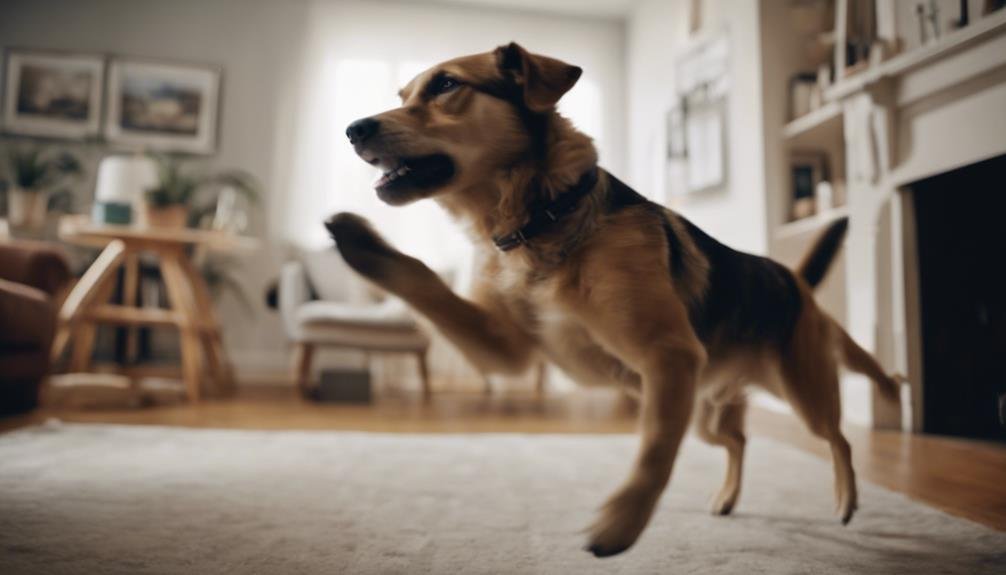
Recognizing the root causes of jumping behavior is crucial in effectively addressing and modifying this common dog behavior. Understanding why a dog jumps up can help in tailoring the training approach to suit the specific needs of the dog.
Here are some underlying reasons for jumping behavior:
- Seeking attention or engagement
- Emotions such as excitement, happiness, boredom, or anxiety
- Lack of understanding of dog body language
- Reinforcement of jumping behavior due to misinterpreting signs of stress, excitement, or anxiety
Identifying these reasons can guide the training process towards successful behavior modification and prevent jumping issues from persisting.
Removing Triggering Situations
To effectively address and modify a dog's jumping behavior, it is essential to proactively remove triggering situations that may lead to unwanted jumping. This can involve using tools like baby gates or crates to separate the dog from potential triggers, such as guests or exciting stimuli. Moving the dog to a different room or area where the triggers are not present can also help control jumping tendencies.
Preventing interactions with guests until the dog calms down can be key in managing the behavior. By temporarily removing the dog from situations that elicit jumping, you can create a calmer environment and begin to work on redirecting the behavior effectively.
Redirecting Focus With Treats
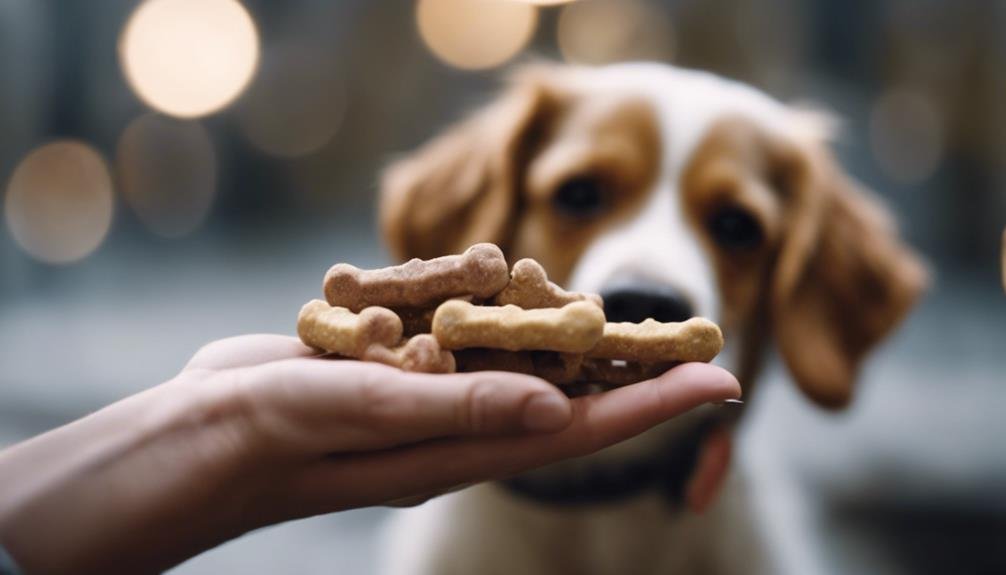
To effectively redirect a dog's focus and discourage jumping behavior, utilizing treats can serve as a valuable tool in positively reinforcing desired actions. Treats can help shift the dog's attention away from jumping and towards more appropriate behaviors.
Here are some ways treats can be used effectively:
- Use high-value treats: Choose treats that are especially enticing for your dog.
- Reward calm behavior: Give treats when the dog is calm and not jumping.
- Consistent timing: Offer treats immediately after the desired behavior to reinforce it effectively.
- Gradually reduce treat frequency: As the dog learns the desired behavior, decrease the frequency of treats while still praising and rewarding intermittently.
Teaching Sit as Alternative
How can you effectively teach a dog to sit as an alternative behavior to jumping up? Teaching a dog to sit can be a valuable tool in redirecting their behavior when they are prone to jumping up on people. By training them to sit on command, you provide them with an alternative action that is more acceptable and less intrusive. Here is a helpful table outlining steps to teach your dog to sit effectively:
| Steps to Teach Sit |
|---|
| 1. Use treats or toys to lure your dog into a sitting position. |
| 2. Pair the verbal cue "sit" with the action of sitting. |
| 3. Reward your dog with treats or praise when they sit on command. |
| 4. Practice regularly in various environments to reinforce the behavior. |
Seeking Professional Help
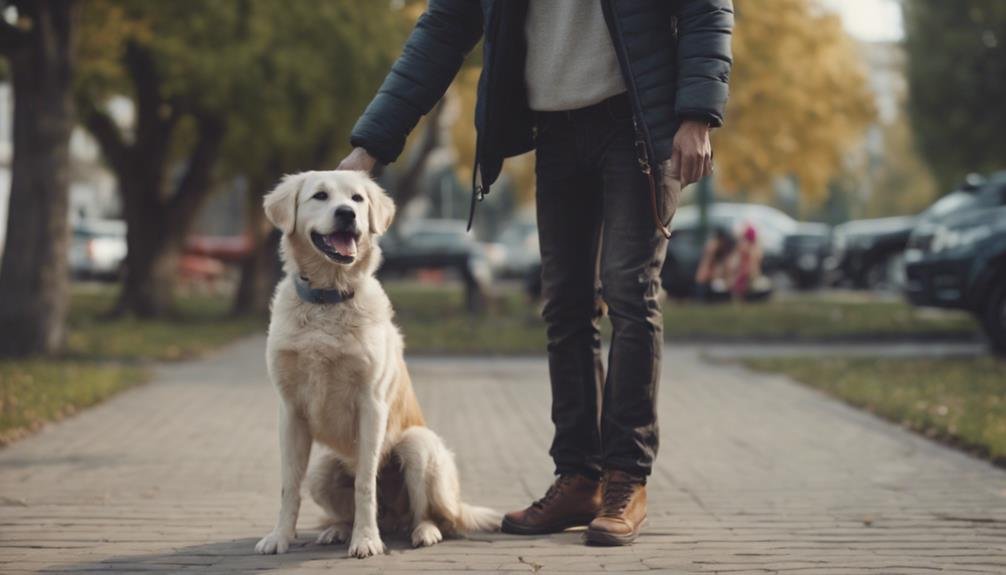
If teaching your dog to sit as an alternative behavior proves challenging despite consistent efforts, consulting a professional trainer or behaviorist can provide tailored guidance and support for addressing the jumping behavior effectively. Professional help can offer personalized strategies to modify your dog's behavior and address any underlying issues contributing to the jumping habit.
Benefits of Seeking Professional Help:
- Individualized training plans based on your dog's specific needs.
- Expert guidance on implementing effective techniques for behavior modification.
- Support in understanding and addressing the root cause of the jumping behavior.
- Access to professional advice and resources to create a structured training program.
Using Tools for Separation
Utilizing tools such as baby gates or crates can effectively aid in separating the dog from triggering situations to manage and prevent jumping behavior.
When faced with situations where the dog may jump on guests or strangers, these tools provide physical barriers that help create a safe space for the dog to calm down.
Baby gates can be used to block off areas where the dog tends to exhibit jumping behavior, while crates offer a secure and confined space for the dog to relax.
By using these tools for separation, it becomes easier to control the dog's interactions and prevent reinforcement of jumping habits.
Implementing these tools strategically can contribute significantly to training efforts aimed at curbing jumping behavior.
Moving Dog to Different Room
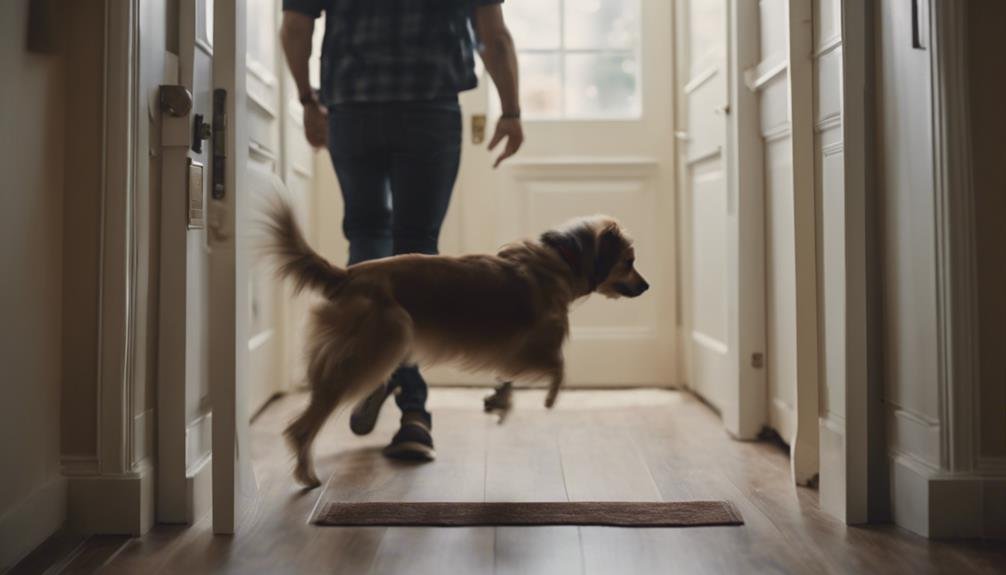
When managing a dog's jumping behavior, relocating the dog to a different room can be a strategic method to control their interactions effectively. This technique can help prevent the reinforcement of jumping behavior and create a calmer environment for both the dog and guests.
Utilizing this approach requires some considerations:
- Provide the dog with a safe and comfortable space away from triggers.
- Allow the dog time to calm down and relax in the separate room.
- Use this time to redirect the dog's focus with calming activities or toys.
- Reintroduce the dog gradually to the situation once they have settled down.
Preventing Interactions With Guests
To effectively manage a dog's jumping behavior, creating boundaries to prevent interactions with guests is a crucial step in fostering a calm and controlled environment. One effective way to prevent interactions with guests is by using barriers or controlled environments. Below is a table that highlights some practical methods to prevent interactions with guests:
| Method | Description | Benefits |
|---|---|---|
| Using baby gates | Restricts access to guests by confining the dog to a room | Provides a safe space for the dog |
| Crating the dog | Secures the dog in a crate during guest visits | Helps manage the dog's behavior |
| Controlled leashing | Keep the dog on a leash when guests arrive | Allows for better control and supervision |
Using Treats and Toys for Distraction
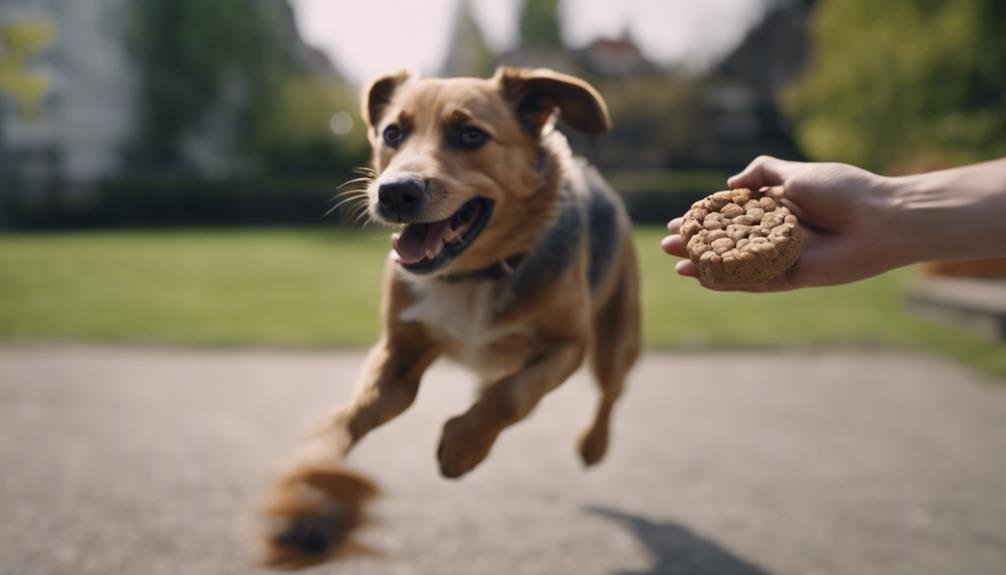
Incorporating treats and toys strategically can effectively divert a dog's attention from jumping behavior towards more desirable interactions. Using treats and toys for distraction can be a powerful tool in training your dog to greet guests politely.
Here are some tips for using treats and toys effectively:
- Keep treats or toys by the door to distract the dog when guests arrive.
- Encourage positive interactions with visitors using treats or toys.
- Condition the dog to associate guests with positive experiences.
- Redirect attention with toys or treats to discourage jumping behavior.
Avoiding Engagement When Jumping
Using treats and toys strategically can effectively divert a dog's attention from jumping behavior towards more desirable interactions. When a dog jumps up, avoiding engagement is crucial to discourage this behavior. Ignoring the dog when it jumps and instructing guests to do the same can send a clear message that jumping is not acceptable. Instead, rewarding calm behavior with attention and treats reinforces positive actions. Teaching the dog to sit and stay provides an alternative behavior to jumping. Consistent training and positive reinforcement will help solidify these teachings.
| Avoiding Engagement | |
|---|---|
| Strategy | Description |
| Ignore the dog's jumps | Refrain from giving any attention when the dog jumps. |
| Instruct guests | Educate visitors not to engage with the dog if it jumps. |
| Reward calm behavior | Acknowledge and reward the dog when it remains calm. |
Consistent Training and Positive Reinforcement
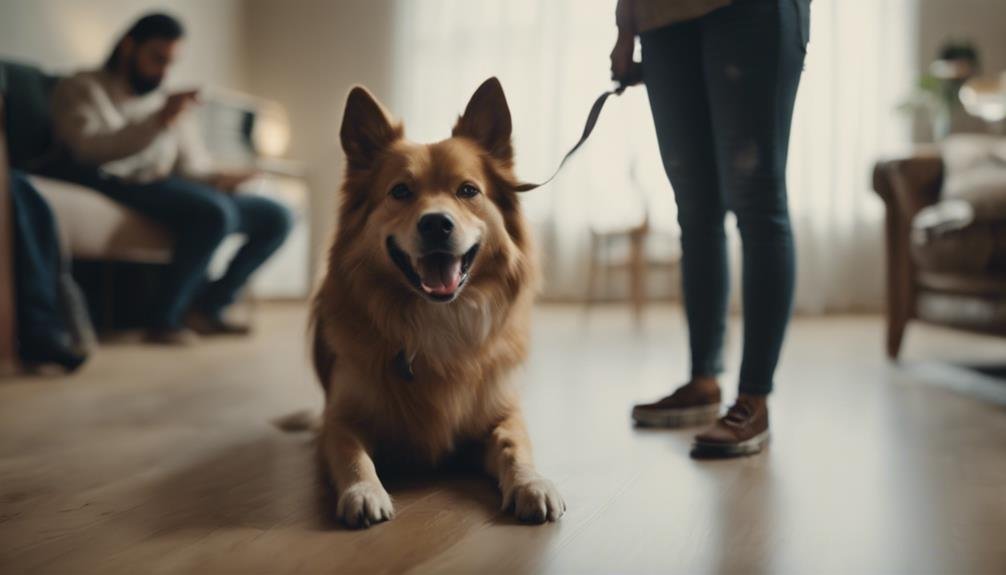
Consistency in training methods and the use of positive reinforcement are fundamental components in effectively modifying a dog's behavior, particularly when addressing jumping tendencies.
When training your dog to stop jumping up, consider the following techniques:
- Establish Clear Rules: Set clear boundaries and consistently enforce them.
- Reward Good Behavior: Use treats, praise, or toys to reward your dog when they refrain from jumping.
- Ignore Unwanted Behavior: Withdraw attention or turn away when your dog jumps up, teaching them that jumping does not result in positive outcomes.
- Use Clicker Training: Incorporate a clicker to mark the desired behavior and reinforce it with treats.
What Can I Do to Stop a Dog From Jumping Up and Behaving Properly in My Yard?
If you’re struggling with your dog jumping up and misbehaving in your yard, there are a few steps you can take to address the issue. Start by training your dog to understand basic commands and boundaries. Additionally, consider using positive reinforcement techniques to encourage good behavior. Banning dogs from yard waste can also help prevent unwanted behavior.
Conclusion
In conclusion, addressing the behavior of dogs jumping up on people requires understanding the reasons behind this action and implementing targeted training techniques.
By identifying triggers, redirecting focus, and consistently using positive reinforcement, owners can effectively deter their dogs from engaging in this behavior.
Through these efforts, a harmonious relationship can be fostered between dogs and their human companions, leading to a more enjoyable and respectful interaction for all parties involved.




